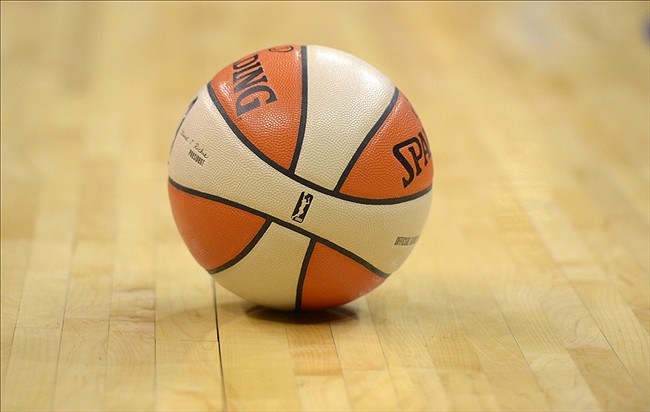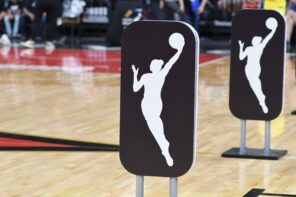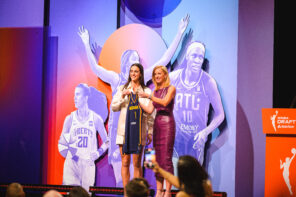As the WNBA prepares to enter year 22 of its existence, there are still plenty of issues president Lisa Borders and NBA commissioner Adam Silver have to wrestle with.
In addition to the long-term future of the New York Liberty and potential expansion to San Francisco and other cities, Adam Silver recently gave attention to the W’s much-ballyhooed issue of attendance.
Silver was a guest on the ESPN morning show, Get Up!, which is co-hosted by Michelle Beadle, Mike Greenberg, and Jalen Rose. He was talking about his frustrations with WNBA attendance figures and why he feels the league is struggling in connecting with young millennial women.
We still have a marketing problem and we gotta figure it out. We gotta figure out how we can do a better job connecting to young people and how they could become interested in women’s basketball.
This is without question an issue that has to be addressed by the league. The WNBA has an automatic market of young girls who want to be basketball players, but for some reason, when most of them name who their favorite basketball players are, they’ll say LeBron James, Kevin Durant, or Stephen Curry instead of Maya Moore, Elena Delle Donne, or Diana Taurasi.
Then, Silver shifted the conversation of making a radical change within the WNBA by moving the season from the summer months to the fall and winter months where it would run concurrent with the NBA season.
This is when a lightbulb clicked off and we began to think maybe Silver could be doing too much.
Firstly, having the WNBA season during the same months as the NBA and women’s and men’s college basketball would be a huge problem for the players because a great deal of them have overseas commitments. If the WNBA even thinks of moving the season from the summer to the fall/winter, the WNBPA will ask teams to pony up more money in salaries to make up for the lost income of going overseas.
Secondly, having the WNBA season during the fall and winter is not good exposure for the league. It would be competing in the same stratosphere as the NFL, college football, the NBA, NHL, college basketball, etc. We already lament about how much the mainstream media does not give the WNBA/women’s basketball the attention it deserves unless it is to pile onto the sport (see: the UConn debate) and moving it to the fall and winter months would only exacerbate that problem.
Right now, the WNBA only competes with one other major sport – and that is Major League Baseball which has an even bigger problem with attracting millennials than Silver claims the W has. NASCAR does not appear to be much of a threat as its flagship stars are slowly, but surely, retiring from the sport and it has to find new ways to market new drivers – such as African-American Bubba Wallace – to new fans.
Thirdly – scheduling conflicts. Having the regular season run around the same time as the NBA and college basketball campaigns would create immense – and we mean immense – scheduling problems for the teams. Out of the 12 teams, five (Sparks, Mercury, Mystics, Fever, Lynx) play in arenas that also house NBA teams.
That is not even counting the Liberty who will play a couple of games back at Madison Square Garden this year or the Storm whose KeyArena will soon become a new arena that will play host to NHL and NBA teams. It is also not counting the Aces, whose owners see a future NBA team in Vegas as well or the Sky, Wings, and Dream who currently play in venues that are also home to college teams.
And when Philips Arena’s renovations are complete, the Dream will rejoin the five aforementioned teams which play in NBA stadia.
There is a lot the W gets wrong – we know this. But there is also a lot the W gets right.
Let us start with the updated playoff format. Without that playoff format, we would not have been blessed with witnessing two of the greatest Finals in league history between the league’s two best teams in the Los Angeles Sparks and Minnesota Lynx. There is a good chance Sparks vs. Lynx could become a trilogy at the end of the 2018 season and that Finals would go five games just as the last two have.
Secondly, the WNBA’s deal with Twitter has broadened the reach of the league by offering games online for free with live streaming. Also, the NBA Live deal was a big one as well.
Thirdly – the All-Star Game. Slowly, but surely under Borders, the WNBA All-Star Game is morphing from just a standalone game that was confined to Phoenix, Connecticut, and New York to more of an event. Look at the way Seattle went all out in promoting last year’s All-Star Game at KeyArena. Minnesota has a tough act to follow.
Also, the first two All-Star Games under the tenure of Borders have/will be in places that have never previously hosted an All-Star Game.
Fourthly – the players themselves. The WNBA’s talent pool is sky-high and is only getting higher. The number of great players that are in this league is staggering. Maya Moore, Elena Delle Donne, Diana Taurasi, Breanna Stewart, Tina Charles, Sylvia Fowles, Candace Parker, Nneka Ogwumike, Jonquel Jones, Skylar Diggins-Smith, Angel McCoughtry, Rebekkah Brunson, Alana Beard, Sue Bird, Alyssa Thomas, Kristi Toliver, and Sugar Rodgers, are just some of the marquee names the W presents.
Add recent draftees such as A’ja Wilson, Kelsey Mitchell, Victoria Vivians, Diamond Deshields, Gabby Williams, Kia Nurse, and Monique Billings into the mix and we have a league that is overflowing with talent and will still be if/when it expands.
And do not get us started on how “boring” the WNBA is because the players may not always throw down highlight dunks like the Sun’s Jonquel Jones did during last year’s All-Star Game. For all of the talk of how the W is based in fundamentals, guess who else was also based in fundamentals?
The San Antonio Spurs. Last time we checked, fundamentals and coaching worked very well for Gregg Popovich and the Spurs from 1999 until 2014.
The W may not be perfect – it has its shortcomings, but all professional sports franchises do. The fact that David Stern had the vision to even create a professional basketball league for women that has become the most successful women’s league in history is a positive in itself.
Can the WNBA do better in marketing its star players and the league as a whole? Absolutely. One can make an argument to say that the women’s basketball tournament should have been inundated with the 2018 batch of “Watch Me Work” spots. Perhaps more young girls would want to emulate Maya Moore if there were more advertisements featuring her.
But from where we come from, a 12-team league that may or may not soon become a 13 or 14-team league is a pretty darn good start.





